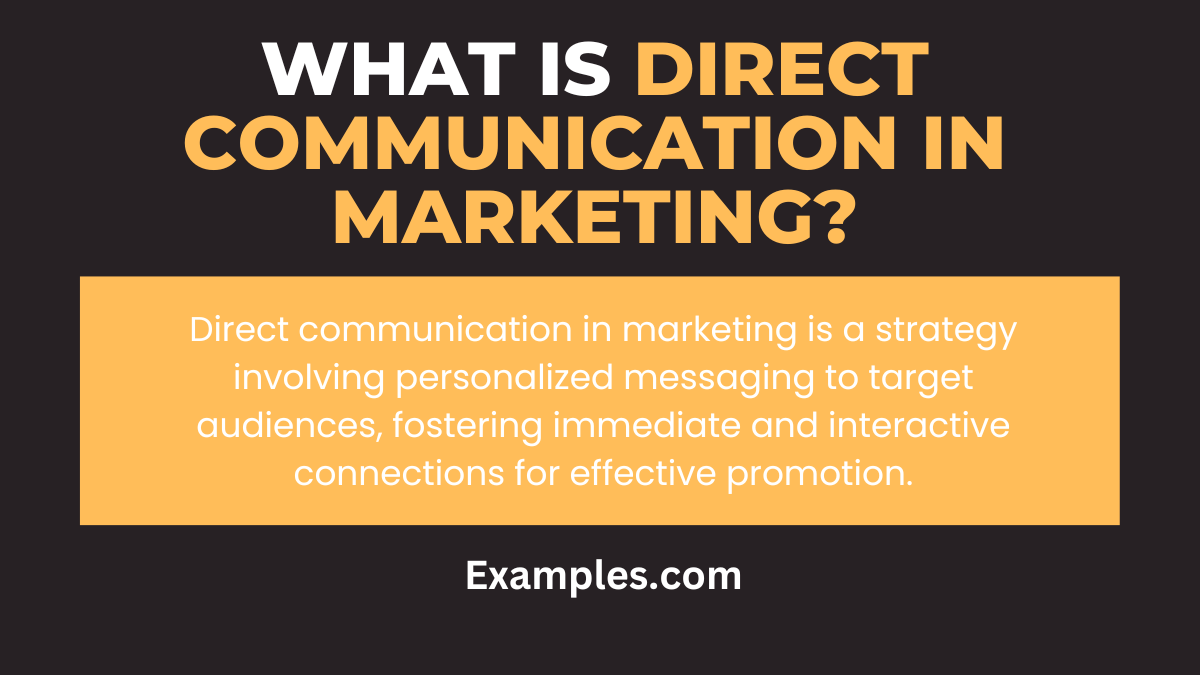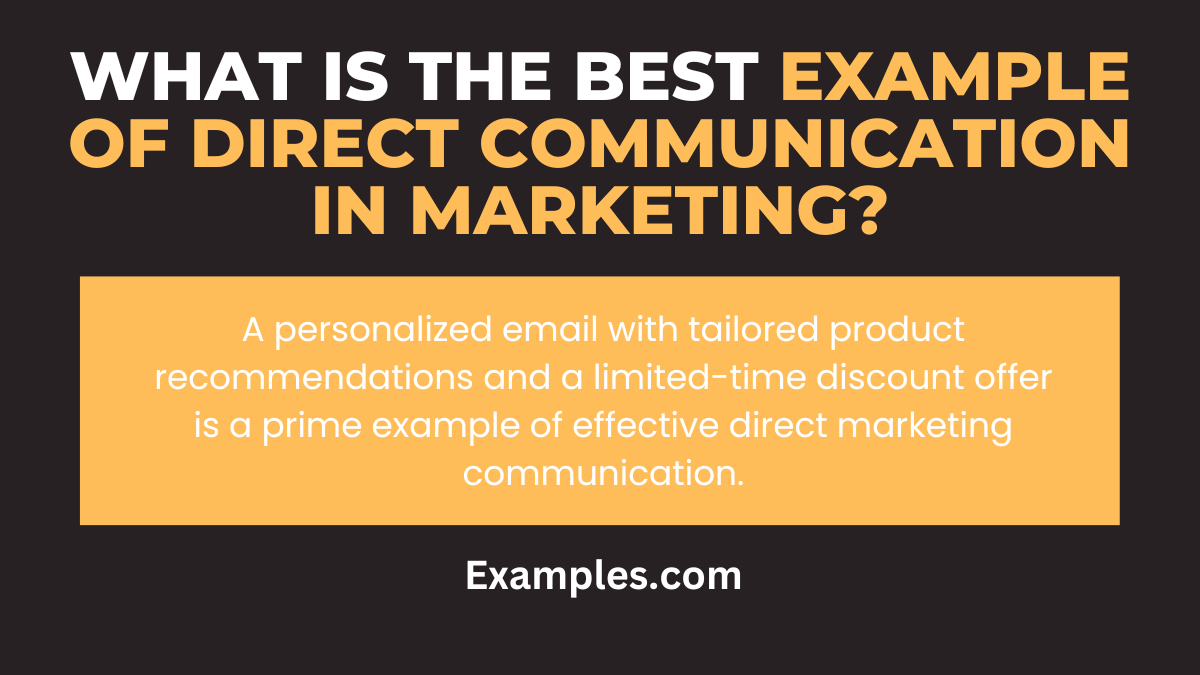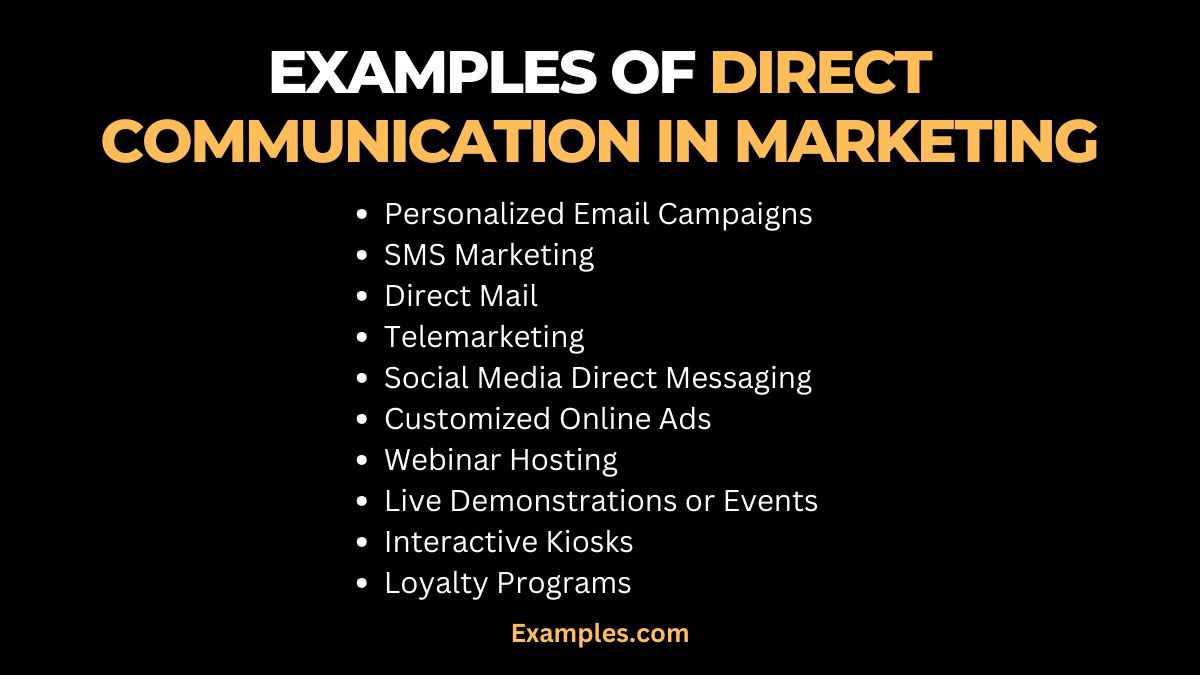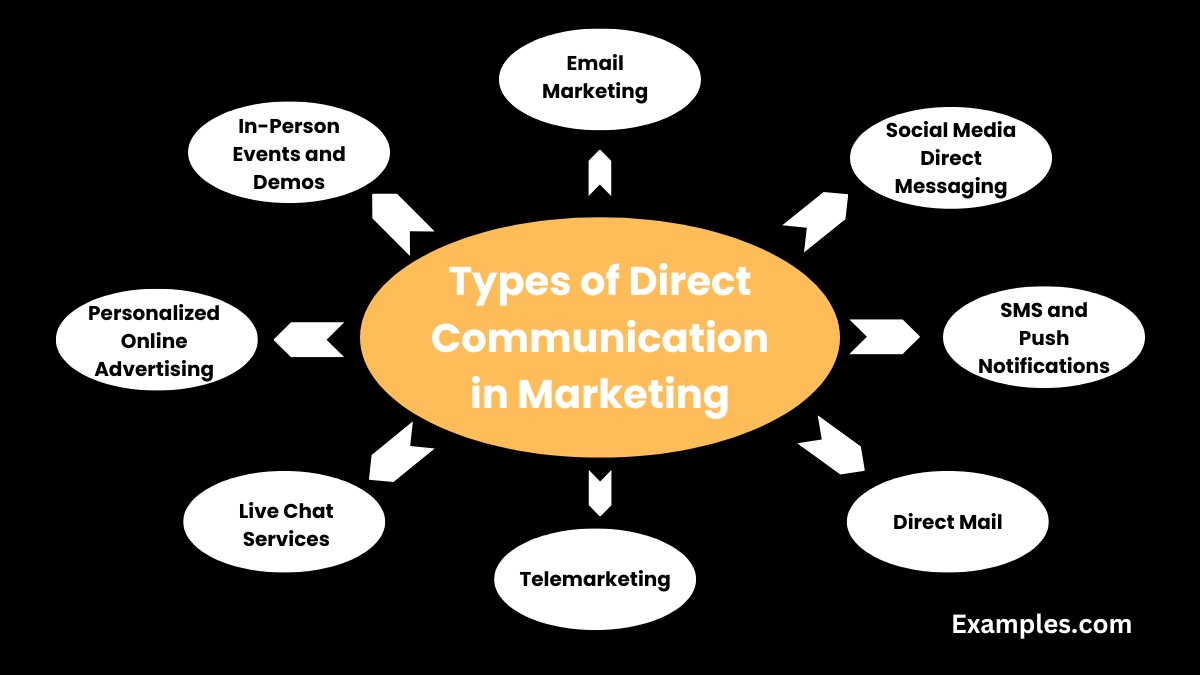9+ Direct Communication in Marketing Examples
In the realm of effective marketing, Direct Communication in Marketing stands out for its impact and precision. This comprehensive guide delves into various facets of this approach, offering insightful Marketing Communication Examples. From engaging directly with consumers to crafting personalized messages, this guide highlights the significance of direct communication in shaping marketing strategies. Here, you’ll find examples that not only illuminate the concept but also demonstrate its practical application in the dynamic world of marketing.
Download List of Direct Communication in Marketing
What is Direct Communication in Marketing?

Direct communication in marketing is a strategy that involves a direct interaction between a business and its customers, bypassing any third-party intermediaries. This approach is characterized by its personalized nature and the use of direct channels like emails, direct mail, phone calls, and text messages. The essence of direct communication is to establish a one-on-one connection, offering tailored messages that cater specifically to the individual needs and preferences of each customer. This method is integral to building strong customer relationships and is a key component of effective Marketing Communication Strategies.
What is the Best Example of Direct Communication in Marketing?

One of the most effective examples of Direct Communication in Marketing is Email Marketing. This approach involves sending personalized emails to a segmented audience, focusing on delivering content that is relevant and valuable to the recipient. Email marketing can include newsletters, promotional offers, or updates about products or services. The strength of this method lies in its ability to personalize communication based on customer data, such as purchase history or browsing behavior. This level of personalization not only enhances the customer experience but also significantly boosts engagement and conversion rates, making it a cornerstone of Marketing Communication Plans.
10 Examples of Direct Communication in Marketing

Direct Communication in Marketing thrives on its ability to connect brands directly with consumers. This strategy, pivotal in today’s marketing landscape, leverages targeted email campaigns, personalized messaging, and other direct channels to foster a more intimate and effective consumer relationship. Each example below not only illustrates the method but also highlights the typical response and approach used.
- Personalized Email Campaigns: Tailored emails based on consumer behavior and preferences, often resulting in higher engagement and conversion rates.
- SMS Marketing: Sending text messages with promotions or updates, leading to immediate reads and often quick responses.
- Direct Mail: Physical mailings like brochures or postcards, offering a tangible brand experience and often yielding a strong emotional response.
- Telemarketing: Direct phone calls to consumers, creating real-time engagement and often leading to immediate feedback or sales.
- Social Media Direct Messaging: Engaging with customers through social media DMs, fostering a personal connection and instant feedback.
- Customized Online Ads: Targeted ads based on user activity and preferences, leading to higher relevance and click-through rates.
- Webinar Hosting: Interactive online seminars that provide valuable information and engage participants in real-time.
- Live Demonstrations or Events: Hosting live events to showcase products, creating a memorable brand experience and direct customer feedback.
- Interactive Kiosks: On-site digital displays that engage customers, providing information and collecting instant feedback.
- Loyalty Programs: Offering personalized rewards to customers, enhancing loyalty and encouraging continuous interaction with the brand.
Types of Direct Communication in Marketing

Direct Communication in Marketing takes various forms, each tailored to create a more personalized and impactful interaction with the audience. These methods are designed to directly engage consumers, often resulting in higher response rates and deeper customer relationships.
- Email Marketing: This involves sending targeted, personalized emails to a segmented audience, offering the flexibility to convey detailed messages and promotions.
- Social Media Direct Messaging: Engaging customers directly through social media platforms, allowing for instant and personalized communication.
- SMS and Push Notifications: Utilizing text messages or app notifications to deliver timely and relevant information to consumers.
- Direct Mail: Sending physical mail, such as brochures or postcards, to offer a tangible brand experience and reach customers offline.
- Telemarketing: Using phone calls to directly communicate with consumers, ideal for real-time interaction and immediate feedback.
- Live Chat Services: Offering real-time assistance and support through websites or apps, facilitating instant customer service.
- Personalized Online Advertising: Using online ads targeted to individual consumer behaviors and preferences, ensuring relevant and direct communication.
- In-Person Events and Demos: Hosting live events to directly engage with customers and provide hands-on experiences with products or services.
Importance of Direct Communication in Marketing
- Personalization: Direct communication allows marketers to tailor messages to individual customers. This personal touch enhances customer experience and increases engagement.
- Immediate Feedback: Unlike other Marketing Communication Channels, direct communication enables immediate feedback from customers. This real-time response is crucial for adjusting strategies quickly.
- Cost-Effective: Direct communication is often more cost-effective than traditional marketing methods. It reduces the need for expensive advertising space and media buys.
- Building Relationships: By communicating directly, companies can build stronger, long-lasting relationships with their customers, fostering loyalty.
- Increased Conversion Rates: Personalized communication often leads to higher conversion rates as messages resonate more with the target audience.
- Better Data Collection: Direct interaction with customers provides valuable data about their preferences, behaviors, and feedback, crucial for Marketing Communication Strategies.
- Control Over Message: Direct communication ensures that the company has complete control over the message being delivered, maintaining brand consistency.
- Segmentation and Targeting: It allows for precise segmentation and targeting, ensuring that the marketing efforts are focused on the most receptive audience segments.
Characteristics of Direct Communication in Marketing
- Two-Way Interaction: Unlike traditional marketing, direct communication is inherently two-way, fostering a dialogue between the business and the customer.
- Personalization: Messages are often personalized to address the specific needs, preferences, or past interactions of the customer.
- Targeted: Direct communication is highly targeted, focusing on individuals or small, well-defined audience segments.
- Measurable: The impact of direct communication campaigns is easily measurable, allowing marketers to analyze effectiveness and ROI.
- Immediate: Direct communication often elicits immediate responses, making it an effective tool for time-sensitive offers or information.
- Technology-Driven: Modern direct communication heavily relies on digital technologies, including email, social media, and mobile apps.
- Privacy-Conscious: It requires a careful balance between personalization and privacy, respecting customer data and their preferences regarding communication.
- Integrated Approach: Effective direct communication is often part of a broader Marketing Communication Plan, integrated with other marketing efforts for consistency and reinforced messaging.
Advantage and Disadvantage of Direct Communication in Marketing
Direct Communication in Marketing offers a unique set of advantages and disadvantages, impacting how businesses connect with their audience. Understanding these can help in optimizing marketing strategies for better results.
| Advantages of Direct Communication in Marketing | Disadvantages of Direct Communication in Marketing |
|---|---|
| Personalized Customer Experience: Direct Communication allows for highly personalized interactions, making customers feel valued and understood. | Perceived Intrusiveness: Sometimes, direct marketing tactics can be seen as intrusive, leading to negative consumer perceptions. |
| Immediate Feedback: This approach enables immediate consumer feedback, essential for quick adjustments and improvements. | Cost Considerations: Customized and direct marketing efforts can be more expensive than broad-spectrum advertising techniques. |
| Higher Engagement Rates: Personalized and direct messages often result in higher engagement and response rates. | Data Privacy Concerns: Collecting and using customer data for personalization can raise privacy concerns and requires careful handling. |
| Measurable Results: The impact of Direct Communication campaigns is easily measurable, allowing for clear assessment of ROI. | Limited Reach: This strategy may not be as effective in reaching new audiences compared to mass marketing methods. |
| Strong Customer Relationships: Direct interactions foster stronger, long-lasting customer relationships. | Dependence on Technology: Effective direct marketing often relies heavily on technology, which might be a barrier for some businesses. |
| Increased Conversion Rates: Targeted communication leads to higher conversion rates as messages resonate more with the audience. | Risk of Message Overload: With numerous brands using direct communication, consumers might feel overwhelmed, leading to message fatigue. |
By weighing these pros and cons, marketers can craft Direct Communication in Marketing strategies that are effective, efficient, and customer-centric, aligning with both business objectives and consumer preferences.
Common Challenges of Direct Communication in Marketing and How to Avoid Them
Direct communication in marketing, such as Email Marketing Communication and Social Media Marketing Communication, is a powerful tool for building personal connections with customers. However, this approach comes with its own set of challenges. Understanding these challenges and implementing effective strategies can significantly enhance the effectiveness of your Marketing Communication Strategies.
1. Overwhelming the Audience
Challenge: Bombarding customers with too many messages can lead to message fatigue, making them disengage.
Solution: Implement a balanced communication frequency. Use customer data to understand their preferences and tailor the frequency accordingly.
2. Lack of Personalization
Challenge: Generic messages fail to resonate with the audience, leading to low engagement.
Solution: Utilize data analytics to segment your audience and customize your messages. Personalization should reflect in every aspect of Direct Communication in Marketing, from addressing the recipient by name to offering relevant content.
3. Inconsistent Brand Messaging
Challenge: Inconsistent messaging across different Marketing Communication Channels can confuse customers about your brand identity. Solution: Develop a comprehensive Marketing Communication Framework that ensures consistency in tone, style, and message across all channels.
4. Ignoring Customer Feedback
Challenge: Not paying attention to customer feedback can lead to missed opportunities for improvement.
Solution: Actively seek and incorporate customer feedback. Tools like surveys and social media interactions can be instrumental in this process.
5. Privacy Concerns
Challenge: With increasing data privacy concerns, customers are wary of how their information is used.
Solution: Be transparent about your data collection and usage policies. Ensure compliance with data protection regulations to build trust.
By addressing these challenges, businesses can optimize their Direct Communication in Marketing efforts, leading to stronger customer relationships and improved business outcomes. Remember, the key to effective direct communication is understanding and respecting your audience’s preferences while delivering value through your messaging.
What is the Focus of Most Direct Marketing Communications?
The focus of most direct marketing communications is to engage consumers personally, prompting immediate action or response through personalized messaging.
Why is Direct Marketing Communications Effective?
Direct marketing communications are effective due to their personalized approach, enabling targeted messaging that resonates more deeply with individual consumers.
What is Direct and Indirect Marketing Communication?
Direct marketing communication involves personal, one-to-one interaction with consumers, while indirect marketing uses broad, non-personal channels like mass media.
Direct Communication in Marketing, with its diverse examples, responses, methods, and tools, offers a personalized and effective way to engage customers. By understanding and utilizing these strategies, businesses can foster stronger relationships, achieve higher engagement rates, and drive more meaningful interactions, ultimately leading to increased customer loyalty and business success.



